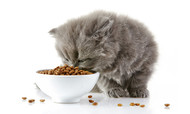Neophobic or Neophilic Behaviour in Cats
29th Aug 2023

Cats’ eating habits tend to fall into one of two categories :-
Neophobic
(having an intense or irrational dislike of anything new or unfamiliar).
Neophilic
(pursuing new food resources or tendency to like new food choices).
Neophobia is when a cat is very reluctant to try new foods. It is important not to discontinue their old diet until your cat is consistently eating the new diet. On the other hand, some cats will exhibit a different feeding habit called Neophilia. In this condition, a cat seeks out a new food source.
Food preferences tend to develop early in a cats life, influenced in many cases by what their mother eats. This stresses the benefit of presenting kittens with a range of foods, so that variety is to be enjoyed rather than feared. Alternatively, it is important to start them on a high protein, meat based, species appropriate food, to ensure they continue to eat a healthy, nutritious diet throughout their lives.


Cats require a high amount of meat proteins, which contain those nutrients that they cannot manufacture.
The home environment also plays an important role, because similar to many species, cats are generally more interested in ‘novel’ (new) foods, when they feel safe. This means that in a comfortable situation, a cat’s eating habit is more likely to be Neophilic. In an unfriendly environment, they favour familiar, safe, food choices & may therefore be more neophobic – not wanting to try new foods.
An alternative way to look at behaviour:-
Observing cats eating behaviours, from their perspective, leads directly to some ideas about the causes. As we are aware, cats are a prey as well as predator species, they are themselves vulnerable to prey while they eat. For this reason, cats in a threatening environment will choose to gobble their meal, pick at it or remove small portions away from their feeding station or other cats to consume where they don’t feel so vulnerable, before returning for more.
All these activities minimise the time spent in what the cat perceives as a ‘hostile’ area. These can include noisy household appliances, outdoor machinery, or hectic human traffic areas, to name a few.
As we are aware, cats are very nimble and swift. They enjoy playing, exploring and defending their territory. Despite this fact they spend almost 90% of the day sleeping, even when their metabolism is very active and for this reason, we need to feed them with foods which contain a rich source of proteins and fats. They should also have access to a bowl of fresh water. In the wild, cats are occasional eaters and can survive a considerable amount of time without food, but they cannot sustain a shortage of water. However, when eating the correct diet ie. A moisture rich, high protein food, they will obtain most of the moisture they require from the diet.
Neophobic cats will usually avoid any new food also called “fixation of food habits”. It is though, more common for cats generally, to be neophlic, as carnivorous animals tend to want to diversify their diet, or seek out foods that help them to achieve a better nutritional balance.
This behaviour is part of a strategy for food selection. By preference, animals consume foods that provide a balanced diet. They will quite often, avoid taking the risk of eating new, unknown foods. This means that trying to introduce a new diet under unusual circumstances, or when an animal is stressed, is more likely to result in neophobia, than if the new food is introduced under familiar, stress-free conditions. So, when introducing your cat to a different type of food, you should always ensure that it is done gradually and with patience, under the least stressful conditions.
Some cats may seem to prefer sticking to their usual diet (that they may have eaten since being a kitten) and may sniff a new food and initially seem uninterested. However, research has shown, that if the food is palatable & nutritious and introduced gradually over several days most cats will end up trying it, out of curiosity. If they find the food to be acceptable, they will usually continue to eat it.
So, if you establish a well-balanced food source, and transition a cat in the correct way, this can be a good way to overcome neophobic cats. Although cats are animals that tend to prefer routine, they can be changed to an alternative food source if this is done in an appropriate manner.

In summary, we see that cats do generally fall into one of these two neophobic, or neophilic, groups. But, by ensuring that your cat always eats in a comfortable, calm, environment and any change in diet, is done gradually, it is possible to assist neophobic cats, to become more neophilic and more likely to try a different food.
If you are trying to transition your cat on to PurrForm, to give a more natural, nutritious diet to your cat, follow our guidelines on “how to transition your cat” on our website.
